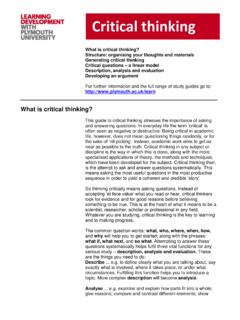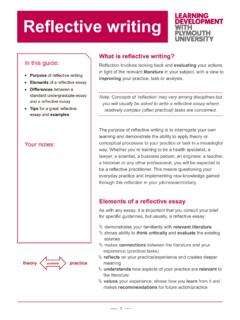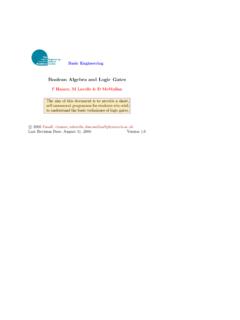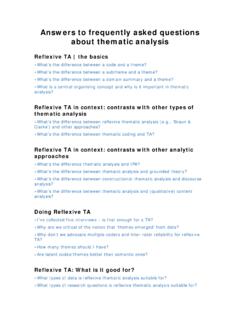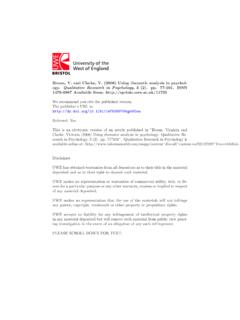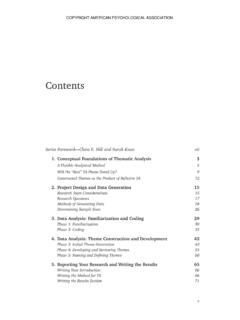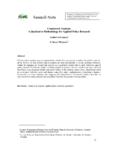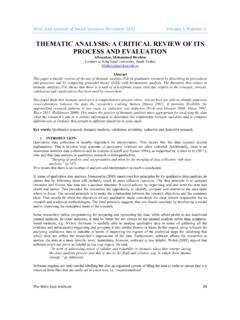Transcription of Thematic analysis of qualitative data: AMEE Guide No. 131
1 Full Terms & Conditions of access and use can be found TeacherISSN: 0142-159X (Print) 1466-187X (Online) Journal homepage: analysis of qualitative data: AMEE GuideNo. 131 Michelle E. Kiger & Lara VarpioTo cite this article: Michelle E. Kiger & Lara Varpio (2020): Thematic analysis of qualitative data: AMEE Guide No. 131, Medical Teacher, DOI: link to this article: online: 01 May your article to this journal Article views: 2167 View related articles View Crossmark dataAMEE GUIDET hematic analysis of qualitative data: AMEE Guide No.
2 131 Michelle E. Kigera,band Lara Varpioa,baWright-Patterson Medical Center, Dayton, OH, USA;bUniformed Services University of the Healthy Sciences, Bethesda, MD, USAABSTRACTT hematic analysis is a widely used, yet often misunderstood, method of qualitative data analysis . Itis a useful and accessible tool for qualitative researchers, but confusion regarding the method sphilosophical underpinnings and imprecision in how it has been described have complicated itsuse and acceptance among researchers. In this Guide , we outline what Thematic analysis is, posi-tioning it in relation to other methods of qualitative analysis , and describe when it is appropriateto use the method under a variety of epistemological frameworks.
3 We also provide a detailed def-inition of atheme, as this term is often misapplied. Next, we describe the most commonly usedsix-step framework for conducting Thematic analysis , illustrating each step using examples fromour own research. Finally, we discuss advantages and disadvantages of this method and alertresearchers to pitfalls to avoid when using Thematic analysis . We aim to highlight Thematic analysisas a powerful and flexible method of qualitative analysis and to empower researchers at all levelsof experience to conduct Thematic analysis in rigorous and thoughtful analysis ; qualitative researchmethods; qualita-tive analysisIntroductionData analysis has been described as the most complex andmysterious of all of the phases of a qualitative project, andthe one that receives the least thoughtful discussion in theliterature (Thorne2000).
4 Many qualitative research paperslack explicit description of the methods informing dataanalysis, or, when included, the terms used to describedata analytic methods are often used imprecisely or aremislabeled entirely (Sandelowski and Barroso2003;Sandelowski2010). Further complicating matters, certainterms describing qualitative data analysis have either car-ried a wide range of definitions or lacked clear imprecision leads to a lack of transparency, making itdifficult for readers to understand how data analysis wasperformed and, consequently, how to interpret findings(Nowell et ).
5 It also contributes to perceptions thatqualitative research is less rigorous than quantitativeresearch (Clarke and Braun2013).Unfortunately, this lack of clear terminology plagues aqualitative data analysis method that is among those mostfrequently used in health professions education (HPE)research: Thematic analysis . Thematic analysisis a term thathas been variably defined (Merton1975; Aronson1995;Boyatzis1998; Attride-Stirling2001; Braun and Clarke2006;Joffe2011), and that has even been discounted asunsophisticated or inferior to other qualitative methods(Braun and Clarke2006,2014).
6 Many researchers who usethematic analysis fail to provide sufficient descriptions ofthe analysis process followed and of the theories or epis-temological assumptions undergirding the analyses(Attride-Stirling2001; Braun and Clarke2006). Additionally,many studies that have employed Thematic analysis havenot explicitly labeled it as such in their manuscripts;instead, these reports simply state that qualitative datawere examined for recurring themes , without offeringfurther explanation (Braun and Clarke2006). Clearly there isconsiderable confusion amongst researchers aboutwhat Thematic analysis means, when to use it, and how touse analysis is a practical data analysis approachfor qualitative researchers; clarifying how to use itPractice points Thematic analysis is a powerful yet flexiblemethod for analyzing qualitative data that can beused within a variety of paradigmatic or epis-temological orientations.
7 Thematic analysis is an appropriate method ofanalysis for seeking to understand experiences,thoughts, or behaviors across a data set. Themes are actively constructed patterns (ormeanings) derived from a data set that answer aresearch question, as opposed to mere summariesor categorizations of codes. Themes can be gen-erated inductively or deductively. The most widely-accepted framework for conduct-ing Thematic analysis involves a six-step process:familiarizing yourself with the data, generating ini-tial codes, searching for themes, reviewingthemes, defining and naming themes, and pro-ducing the report.
8 Given the flexibility of Thematic analysis , research-ers using this method must clearly outline theirparadigmatic orientations and assumptions toensure the trustworthiness of their findings E. Medical Center, 4881 Sugar Maple Dr, Dayton, OH 45433, USA 2020 AMEEMEDICAL and effectively can help HPE researchers rec-ognize its utility, versatility, and power. In this Guide , weaim to support the achievement of these goals. First, wedefine Thematic analysis , focusing on the flexibility that itoffers researchers. We explore how it can be applied acrossa range of theoretical and epistemological frameworks.
9 Wealso suggest when Thematic analysis can be harnessed inqualitative data analysis . Next, we focus on some key con-cepts underpinning Thematic analysis . Specifically, we dis-cuss the definition of a theme, including different types ofthemes ( semantic versus latent), and how inductive ordeductive processes can be employed to develop then describe a stepwise approach for conducting the-matic analysis , following the six-step framework of Braunand Clarke (2006) and providing a worked example fromour own research data to illustrate each step.
10 We concludewith a discussion of the advantages and disadvantages ofusing Thematic analysis , and a description of pitfallsto is Thematic analysis ? Thematic analysis is a method for analyzing qualitativedata that entails searching across a data set to identify,analyze, and report repeated patterns (Braun and Clarke2006). It is a method for describing data, but it alsoinvolves interpretation in the processes of selecting codesand constructing themes. A distinguishing feature of the-matic analysis is its flexibility to be used within a widerange of theoretical and epistemological frameworks, andto be applied to a wide range of study questions, designs,and sample sizes.

